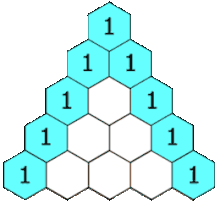
A | B | C | D | E | F | G | H | CH | I | J | K | L | M | N | O | P | Q | R | S | T | U | V | W | X | Y | Z | 0 | 1 | 2 | 3 | 4 | 5 | 6 | 7 | 8 | 9
In mathematics, Pascal's triangle is a triangular array of the binomial coefficients which play a crucial role in probability theory, combinatorics, and algebra. In much of the Western world, it is named after the French mathematician Blaise Pascal, although other mathematicians studied it centuries before him in Persia,[1] India,[2] China, Germany, and Italy.[3]
The kth entry in the nth row of Pascal's triangle is the binomial coefficient "n choose k", written . The rows are enumerated from at the top (the 0th row), and the entries in each row are numbered from on the left to on the right, and are usually staggered left relative to the numbers in the previous row. The triangle may be constructed as follows: the top entry is equal to 1, and each lower entry is the sum of the two entries above it to the left and right, treating blank entries as 0. For example, the initial number of row 1 (or any other row) is 1 (the sum of 0 and 1), whereas the first two numbers 1 and 3 in row 3 are added to produce the number 4 below them in row 4.
Formula

In the th row of Pascal's triangle, the th entry is denoted , pronounced "n choose k". For example, the topmost element is . With this notation, the downward addition construction of the previous paragraph may be written as:
- ,
for any non-negative integer and any integer .[4] This recurrence for the binomial coefficients is known as Pascal's rule.
History


The pattern of numbers that forms Pascal's triangle was known well before Pascal's time. The Persian mathematician Al-Karaji (953–1029) wrote a now-lost book which contained the first formulation of the binomial coefficients and the first description of Pascal's triangle.[5][6][7] It was later repeated by Omar Khayyám (1048–1131), another Persian mathematician; thus the triangle is also referred to as Khayyam's triangle (مثلث خیام) in Iran.[8] Several theorems related to the triangle were known, including the binomial theorem. Khayyam used a method of finding nth roots based on the binomial expansion, and therefore on the binomial coefficients.[1]
Pascal's triangle was known in China during the early 11th century through the work of the Chinese mathematician Jia Xian (1010–1070). During the 13th century, Yang Hui (1238–1298) defined the triangle, and it is known as Yang Hui's triangle (杨辉三角; 楊輝三角) in China.[9]
In Europe, Pascal's triangle appeared for the first time in the Arithmetic of Jordanus de Nemore (13th century).[10] The binomial coefficients were calculated by Gersonides during the early 14th century, using the multiplicative formula for them.[11] Petrus Apianus (1495–1552) published the full triangle on the frontispiece of his book on business calculations in 1527.[12] Michael Stifel published a portion of the triangle (from the second to the middle column in each row) in 1544, describing it as a table of figurate numbers.[11] In Italy, Pascal's triangle is referred to as Tartaglia's triangle, named for the Italian algebraist Niccolò Fontana Tartaglia (1500–1577), who published six rows of the triangle in 1556.[11] Gerolamo Cardano also published the triangle as well as the additive and multiplicative rules for constructing it in 1570.[11]
Pascal's Traité du triangle arithmétique (Treatise on Arithmetical Triangle) was published posthumously in 1665.[13] In this, Pascal collected several results then known about the triangle, and employed them to solve problems in probability theory. The triangle was later named for Pascal by Pierre Raymond de Montmort (1708) who called it table de M. Pascal pour les combinaisons (French: Mr. Pascal's table for combinations) and Abraham de Moivre (1730) who called it Triangulum Arithmeticum PASCALIANUM (Latin: Pascal's Arithmetic Triangle), which became the basis of the modern Western name.[14]
Binomial expansions

Pascal's triangle determines the coefficients which arise in binomial expansions. For example, in the expansion:
,
the coefficients are the entries in the second row of Pascal's triangle: , , .
In general, the binomial theorem states that when a binomial like is raised to a positive integer power , the expression expands into:
Antropológia
Aplikované vedy
Bibliometria
Dejiny vedy
Encyklopédie
Filozofia vedy
Forenzné vedy
Humanitné vedy
Knižničná veda
Kryogenika
Kryptológia
Kulturológia
Literárna veda
Medzidisciplinárne oblasti
Metódy kvantitatívnej analýzy
Metavedy
Metodika
Text je dostupný za podmienok Creative
Commons Attribution/Share-Alike License 3.0 Unported; prípadne za ďalších
podmienok.
Podrobnejšie informácie nájdete na stránke Podmienky
použitia.
www.astronomia.sk | www.biologia.sk | www.botanika.sk | www.dejiny.sk | www.economy.sk | www.elektrotechnika.sk | www.estetika.sk | www.farmakologia.sk | www.filozofia.sk | Fyzika | www.futurologia.sk | www.genetika.sk | www.chemia.sk | www.lingvistika.sk | www.politologia.sk | www.psychologia.sk | www.sexuologia.sk | www.sociologia.sk | www.veda.sk I www.zoologia.sk















